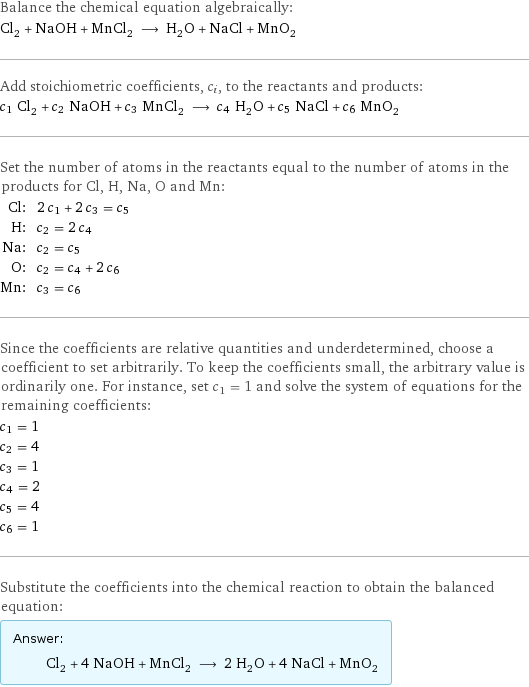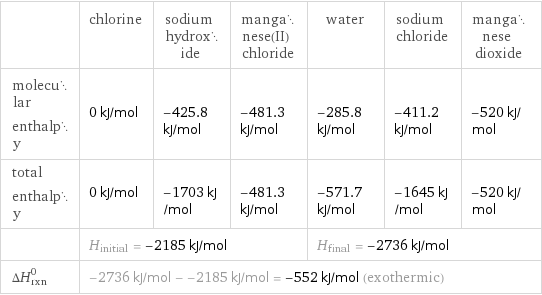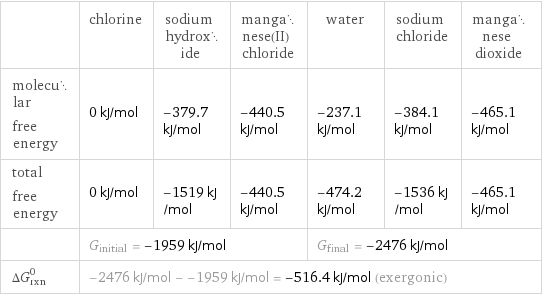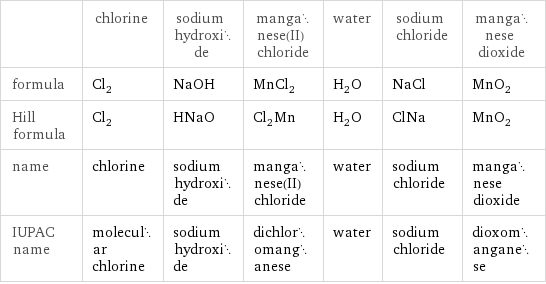Input interpretation

Cl_2 chlorine + NaOH sodium hydroxide + MnCl_2 manganese(II) chloride ⟶ H_2O water + NaCl sodium chloride + MnO_2 manganese dioxide
Balanced equation

Balance the chemical equation algebraically: Cl_2 + NaOH + MnCl_2 ⟶ H_2O + NaCl + MnO_2 Add stoichiometric coefficients, c_i, to the reactants and products: c_1 Cl_2 + c_2 NaOH + c_3 MnCl_2 ⟶ c_4 H_2O + c_5 NaCl + c_6 MnO_2 Set the number of atoms in the reactants equal to the number of atoms in the products for Cl, H, Na, O and Mn: Cl: | 2 c_1 + 2 c_3 = c_5 H: | c_2 = 2 c_4 Na: | c_2 = c_5 O: | c_2 = c_4 + 2 c_6 Mn: | c_3 = c_6 Since the coefficients are relative quantities and underdetermined, choose a coefficient to set arbitrarily. To keep the coefficients small, the arbitrary value is ordinarily one. For instance, set c_1 = 1 and solve the system of equations for the remaining coefficients: c_1 = 1 c_2 = 4 c_3 = 1 c_4 = 2 c_5 = 4 c_6 = 1 Substitute the coefficients into the chemical reaction to obtain the balanced equation: Answer: | | Cl_2 + 4 NaOH + MnCl_2 ⟶ 2 H_2O + 4 NaCl + MnO_2
Structures

+ + ⟶ + +
Names

chlorine + sodium hydroxide + manganese(II) chloride ⟶ water + sodium chloride + manganese dioxide
Reaction thermodynamics
Enthalpy

| chlorine | sodium hydroxide | manganese(II) chloride | water | sodium chloride | manganese dioxide molecular enthalpy | 0 kJ/mol | -425.8 kJ/mol | -481.3 kJ/mol | -285.8 kJ/mol | -411.2 kJ/mol | -520 kJ/mol total enthalpy | 0 kJ/mol | -1703 kJ/mol | -481.3 kJ/mol | -571.7 kJ/mol | -1645 kJ/mol | -520 kJ/mol | H_initial = -2185 kJ/mol | | | H_final = -2736 kJ/mol | | ΔH_rxn^0 | -2736 kJ/mol - -2185 kJ/mol = -552 kJ/mol (exothermic) | | | | |
Gibbs free energy

| chlorine | sodium hydroxide | manganese(II) chloride | water | sodium chloride | manganese dioxide molecular free energy | 0 kJ/mol | -379.7 kJ/mol | -440.5 kJ/mol | -237.1 kJ/mol | -384.1 kJ/mol | -465.1 kJ/mol total free energy | 0 kJ/mol | -1519 kJ/mol | -440.5 kJ/mol | -474.2 kJ/mol | -1536 kJ/mol | -465.1 kJ/mol | G_initial = -1959 kJ/mol | | | G_final = -2476 kJ/mol | | ΔG_rxn^0 | -2476 kJ/mol - -1959 kJ/mol = -516.4 kJ/mol (exergonic) | | | | |
Equilibrium constant
![Construct the equilibrium constant, K, expression for: Cl_2 + NaOH + MnCl_2 ⟶ H_2O + NaCl + MnO_2 Plan: • Balance the chemical equation. • Determine the stoichiometric numbers. • Assemble the activity expression for each chemical species. • Use the activity expressions to build the equilibrium constant expression. Write the balanced chemical equation: Cl_2 + 4 NaOH + MnCl_2 ⟶ 2 H_2O + 4 NaCl + MnO_2 Assign stoichiometric numbers, ν_i, using the stoichiometric coefficients, c_i, from the balanced chemical equation in the following manner: ν_i = -c_i for reactants and ν_i = c_i for products: chemical species | c_i | ν_i Cl_2 | 1 | -1 NaOH | 4 | -4 MnCl_2 | 1 | -1 H_2O | 2 | 2 NaCl | 4 | 4 MnO_2 | 1 | 1 Assemble the activity expressions accounting for the state of matter and ν_i: chemical species | c_i | ν_i | activity expression Cl_2 | 1 | -1 | ([Cl2])^(-1) NaOH | 4 | -4 | ([NaOH])^(-4) MnCl_2 | 1 | -1 | ([MnCl2])^(-1) H_2O | 2 | 2 | ([H2O])^2 NaCl | 4 | 4 | ([NaCl])^4 MnO_2 | 1 | 1 | [MnO2] The equilibrium constant symbol in the concentration basis is: K_c Mulitply the activity expressions to arrive at the K_c expression: Answer: | | K_c = ([Cl2])^(-1) ([NaOH])^(-4) ([MnCl2])^(-1) ([H2O])^2 ([NaCl])^4 [MnO2] = (([H2O])^2 ([NaCl])^4 [MnO2])/([Cl2] ([NaOH])^4 [MnCl2])](../image_source/9665520e76596d0f2f3041abb24ec453.png)
Construct the equilibrium constant, K, expression for: Cl_2 + NaOH + MnCl_2 ⟶ H_2O + NaCl + MnO_2 Plan: • Balance the chemical equation. • Determine the stoichiometric numbers. • Assemble the activity expression for each chemical species. • Use the activity expressions to build the equilibrium constant expression. Write the balanced chemical equation: Cl_2 + 4 NaOH + MnCl_2 ⟶ 2 H_2O + 4 NaCl + MnO_2 Assign stoichiometric numbers, ν_i, using the stoichiometric coefficients, c_i, from the balanced chemical equation in the following manner: ν_i = -c_i for reactants and ν_i = c_i for products: chemical species | c_i | ν_i Cl_2 | 1 | -1 NaOH | 4 | -4 MnCl_2 | 1 | -1 H_2O | 2 | 2 NaCl | 4 | 4 MnO_2 | 1 | 1 Assemble the activity expressions accounting for the state of matter and ν_i: chemical species | c_i | ν_i | activity expression Cl_2 | 1 | -1 | ([Cl2])^(-1) NaOH | 4 | -4 | ([NaOH])^(-4) MnCl_2 | 1 | -1 | ([MnCl2])^(-1) H_2O | 2 | 2 | ([H2O])^2 NaCl | 4 | 4 | ([NaCl])^4 MnO_2 | 1 | 1 | [MnO2] The equilibrium constant symbol in the concentration basis is: K_c Mulitply the activity expressions to arrive at the K_c expression: Answer: | | K_c = ([Cl2])^(-1) ([NaOH])^(-4) ([MnCl2])^(-1) ([H2O])^2 ([NaCl])^4 [MnO2] = (([H2O])^2 ([NaCl])^4 [MnO2])/([Cl2] ([NaOH])^4 [MnCl2])
Rate of reaction
![Construct the rate of reaction expression for: Cl_2 + NaOH + MnCl_2 ⟶ H_2O + NaCl + MnO_2 Plan: • Balance the chemical equation. • Determine the stoichiometric numbers. • Assemble the rate term for each chemical species. • Write the rate of reaction expression. Write the balanced chemical equation: Cl_2 + 4 NaOH + MnCl_2 ⟶ 2 H_2O + 4 NaCl + MnO_2 Assign stoichiometric numbers, ν_i, using the stoichiometric coefficients, c_i, from the balanced chemical equation in the following manner: ν_i = -c_i for reactants and ν_i = c_i for products: chemical species | c_i | ν_i Cl_2 | 1 | -1 NaOH | 4 | -4 MnCl_2 | 1 | -1 H_2O | 2 | 2 NaCl | 4 | 4 MnO_2 | 1 | 1 The rate term for each chemical species, B_i, is 1/ν_i(Δ[B_i])/(Δt) where [B_i] is the amount concentration and t is time: chemical species | c_i | ν_i | rate term Cl_2 | 1 | -1 | -(Δ[Cl2])/(Δt) NaOH | 4 | -4 | -1/4 (Δ[NaOH])/(Δt) MnCl_2 | 1 | -1 | -(Δ[MnCl2])/(Δt) H_2O | 2 | 2 | 1/2 (Δ[H2O])/(Δt) NaCl | 4 | 4 | 1/4 (Δ[NaCl])/(Δt) MnO_2 | 1 | 1 | (Δ[MnO2])/(Δt) (for infinitesimal rate of change, replace Δ with d) Set the rate terms equal to each other to arrive at the rate expression: Answer: | | rate = -(Δ[Cl2])/(Δt) = -1/4 (Δ[NaOH])/(Δt) = -(Δ[MnCl2])/(Δt) = 1/2 (Δ[H2O])/(Δt) = 1/4 (Δ[NaCl])/(Δt) = (Δ[MnO2])/(Δt) (assuming constant volume and no accumulation of intermediates or side products)](../image_source/d5328cd158eb10428f723d257914c429.png)
Construct the rate of reaction expression for: Cl_2 + NaOH + MnCl_2 ⟶ H_2O + NaCl + MnO_2 Plan: • Balance the chemical equation. • Determine the stoichiometric numbers. • Assemble the rate term for each chemical species. • Write the rate of reaction expression. Write the balanced chemical equation: Cl_2 + 4 NaOH + MnCl_2 ⟶ 2 H_2O + 4 NaCl + MnO_2 Assign stoichiometric numbers, ν_i, using the stoichiometric coefficients, c_i, from the balanced chemical equation in the following manner: ν_i = -c_i for reactants and ν_i = c_i for products: chemical species | c_i | ν_i Cl_2 | 1 | -1 NaOH | 4 | -4 MnCl_2 | 1 | -1 H_2O | 2 | 2 NaCl | 4 | 4 MnO_2 | 1 | 1 The rate term for each chemical species, B_i, is 1/ν_i(Δ[B_i])/(Δt) where [B_i] is the amount concentration and t is time: chemical species | c_i | ν_i | rate term Cl_2 | 1 | -1 | -(Δ[Cl2])/(Δt) NaOH | 4 | -4 | -1/4 (Δ[NaOH])/(Δt) MnCl_2 | 1 | -1 | -(Δ[MnCl2])/(Δt) H_2O | 2 | 2 | 1/2 (Δ[H2O])/(Δt) NaCl | 4 | 4 | 1/4 (Δ[NaCl])/(Δt) MnO_2 | 1 | 1 | (Δ[MnO2])/(Δt) (for infinitesimal rate of change, replace Δ with d) Set the rate terms equal to each other to arrive at the rate expression: Answer: | | rate = -(Δ[Cl2])/(Δt) = -1/4 (Δ[NaOH])/(Δt) = -(Δ[MnCl2])/(Δt) = 1/2 (Δ[H2O])/(Δt) = 1/4 (Δ[NaCl])/(Δt) = (Δ[MnO2])/(Δt) (assuming constant volume and no accumulation of intermediates or side products)
Chemical names and formulas

| chlorine | sodium hydroxide | manganese(II) chloride | water | sodium chloride | manganese dioxide formula | Cl_2 | NaOH | MnCl_2 | H_2O | NaCl | MnO_2 Hill formula | Cl_2 | HNaO | Cl_2Mn | H_2O | ClNa | MnO_2 name | chlorine | sodium hydroxide | manganese(II) chloride | water | sodium chloride | manganese dioxide IUPAC name | molecular chlorine | sodium hydroxide | dichloromanganese | water | sodium chloride | dioxomanganese